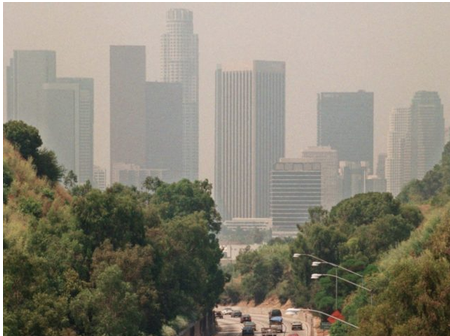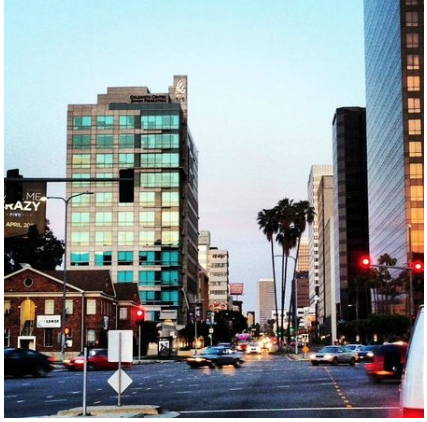CommentsPLATKIN ON PLANNING-Most kids learn how to connect the dots in pre-school, but this skill has faded away for leading members of LA’s urban growth machine, especially the Los Angeles Times and City Hall officials.
For reasons not difficult to figure out, they now have a great deal of trouble to connect the dots. They are just stumped to explain why air quality is getting worse, housing costs and homelessness are climbing, traffic is more congested, and transit ridership is declining. Yet, they are both tireless advocates of the very supply-side land use policies, programs, and practices responsible for these alarming trends.
Why is it so hard for them to understand that their land use policies have consequences and that when they pillage zoning and planning laws for the benefit of real estate speculators, Los Angeles ends up with more traffic congestion, smog, automobile driving, and homelessness? It is time they recovered those pre-school skills to connect the dots, even if it means sacrificing their article of economic faith that “unleashing the private sector” through zoning scams is not the miracle cure their real estate patrons and spinmeisters claim.
The Los Angeles Times. The city’s most prominent newspaper continues to present supply-side advocacy pieces on its editorial pages, while ensuring that competing voices, like those in CityWatch or distinguished urban scholars, such as Professor Michael Storper, remain silenced. For those whose views are strictly formed by this paper, they imagine that gutting zoning regulations can remedy this country’s worsening housing crisis. In practice this means upzoning residential areas throughout the entire state of California, per State Senators Wiener and Skinner. Their Sacramento laws are then somehow supposed to result in more affordable housing, increased transit ridership, and reduced Green House Gases. Even though a growing body of evidence reveals that this let-the-rich-get-richer theory is nonsense, it does not stop the repeated publication of such opinion pieces.
Meanwhile, in separate news stories, the same newspaper describes a host of crises that stem from this nonsense, but which the LA Times treats as the following disconnected and perplexing trends:
Declining transit ridership: According to the paper, “Metropolitan Transportation Authority buses, which carry most of the county's bus riders, have lost nearly 95 million trips over a decade, according to federal data. The 25% drop is the steepest among the busiest transit systems in the United States and accounted for the majority of California’s transit ridership decline.”
As for the cause of this decline? More people can afford cars, but not a word on the systematic displacement of existing transit users through gentrification.
Rising smog levels: Again, according to the LA Times, “Air quality is slipping once again … Nowhere is the situation worse than in Southern California, where researchers found a 10% increase in deaths attributable to ozone pollution from 2010 to 2017. The region has long reigned as the nation’s smog capital and has seen a resurgence of dirty air in the last few years, one that has sharpened the divide between wealthier coastal enclaves with cleaner air and lower-income communities farther inland with smoggy air.
 The paper then blames worsening smog on climate change and geography, without a word about the land use and transportation policies that directly and indirectly promote driving at the expense of walking, bicycling, buses, and subways.
The paper then blames worsening smog on climate change and geography, without a word about the land use and transportation policies that directly and indirectly promote driving at the expense of walking, bicycling, buses, and subways.
(Left: SMOG levels are up in the Los Angeles area.)
Increasing homelessness: The LA Times has published many stories on LA’s growing number of homeless people, especially moving pieces by columnist Steve Lopez, but it never links officially sanctioned gentrification with increased homelessness. Instead, the paper points a finger at the leveling of Bunker Hill in the 1950s, the loss of “crumbling hotels and tenements,” the crack epidemic, and other real but peripheral causes.
For example, “Faced with widespread displacement of poor people during the redevelopment of Bunker Hill's Victorian boarding houses, the city rejected slum clearance of skid row. Instead, officials concentrated very-low-income housing and homeless services in the 50-block district. But it became a dumping ground for hospitals, prisons and other cities to get rid of people with nowhere else to go. Homeless people on skid row were expected to enter shelters, graduate to transitional housing and finally earn permanent housing through good behavior, including sobriety. But many people fell off that path and never returned. The containment policy is now considered a failure.”
Meanwhile, back in La La Land, over 24,000 people have been evicted from rent-stabilized apartments since 2001. This critical component of gentrification is treated separately from the growth of homelessness, as well as those forced out of affordable housing through deliberate negligence and cash-and-key evictions.
Intractable traffic congestion: It is hardly news, but year-after-year Los Angeles has the country’s worst traffic congestion. As for the causes, the paper’s coverage is less clear, with low gas prices and a strong economy identified as the culprits. “Over the next few years, if gas prices remain low and the economy stays strong, drivers in LA and other major cities should expect congestion to increase . . .”
According to the experts interviewed by the LA Times, short of another recession, the only other factor that would slow the steady increase of traffic congestion is autonomous vehicles. Land use is not even mentioned, specifically the proliferation of expensive apartment buildings filled with the enormous parking structures that affluent tenants expect.
LA’s City Hall: City Hall’s outlook mirrors that of the LA Times, but with one exception. City Hall is even bolder in its promotion of developer-guided, supply-side economic schemes as faux remedies for the city’s housing and transportation crises. The best example I know is the Purple Line Extension Transit Neighborhood Plan (TNP). If ever completed, it would conceal an enormous transfer of wealth to real estate developers by (mis)representing it as an innovative planning program to shelter the homeless and increase transit ridership.
This proposal, which the City Council may some day adopt as a complex zoning overlay ordinance, was funded by METRO, then rolled out by LA’s City Planning Department. It is now apparently stalled because Councilmember David Ryu, at the urging of his constituents, sharply criticized the proposal in a skillfully drafted letter to the Director of Planning. This letter called out the TNP’s many shortcomings, including land use policies that would lead to increased automobile driving, traffic congestion, and homelessness.
 (Left: The Miracle Mile already has high density, perfect for a subway.)
(Left: The Miracle Mile already has high density, perfect for a subway.)
As exposed through many CityWatch columns, the TNP was billed as a “plan” to benefit of the adjacent Miracle Mile and Greater Fairfax neighborhoods. The TNP’s elaborate upzoning program was supposed to increase transit ridership and the supply of affordable housing, while also simultaneously reducing transit congestion and slowing climate change in these (already dense) neighborhoods.
These could be the benefits of a well-planned mass transit system, but they have nothing to do with the Purple Line Extension or City Planning’s TNP proposal because the latter rejects the following:
- Sidewalks are left in their existing decrepit state, without new street trees, lighting, ADA curb cuts, scramble intersections, and re-pouring of concrete.
- Bus service remains unchanged, with long headways, poor phone apps, complicated transfers, and unreliable service.
- Bus stops will not be improved, leaving most of them without shelters to protect bus riders from wind, sun, and rain.
- Fares will remain expensive, even though London’s example of free subway and buses for those over 60 has maintained high ridership.
- Purple Line subway stations will not include parking lots, bike sharing, or interfaces for cars, taxis/ubers, buses, shuttles, bicycles, and pedestrians.
- No bicycle/scooter lanes or bicycle/scooter parking areas are planned for the subway stations or the nearby Miracle Mile and greater Fairfax neighborhoods.
- Specific Plan up-zoning ordinances will not require the inclusion of low-income apartments.
- Voluntary low-income density bonus units will not be verified by on-site inspections.
- The forthcoming update of the Wilshire Community Plan would be preempted by the TNP’s unplanned land use changes. As a result, the TNP would not be based on population trends, prior construction patterns, infrastructure capacity, available public services, and local housing needs.
Failing to connect the dots: Why such a blinkered approach that fails to connect the dots? Because in their world “growth” – a euphemism for extremely profitable real estate deals -- is the Holy Grail. Things just happen, and they are not linked to each other unless they happen to fit into this strange world. As a result, few policies and programs have consequences, which is why City agencies seldom monitor trends or assess their own programs.
To make is through the days, weeks, and years, public policies and programs are compartmentalized, without any efforts to determine if they are effective or if they warrant changes.
This is the price that the Los Angeles Times and the City Hall pay for believing their own cover stories, that defying the City’s own ordinances and adopted plans somehow leads to three beneficial outcomes: affordable housing, decreased driving, and increased transit use.
They are not only pulling the wool over their own eyes, but now ignore external studies demonstrating that what they dub “growth” is the cause of those inexplicable trends: homelessness, climate change, and automobile dependency.
If this blinkering were necessary to publish articles in obscure academic journals, few people would care. But this self-deception affects the lives of 4,000,000 people in LA and 13 million in our metropolitan area. When there is a reckoning, we know where blame lies.
(Dick Platkin is a former Los Angeles city planner who reports on local planning controversies for City Watch. He serves on the board of United Neighborhood of Los Angeles (UN4LA) and welcome comments and corrections at [email protected].) Prepped for CityWatch by Linda Abrams.
















